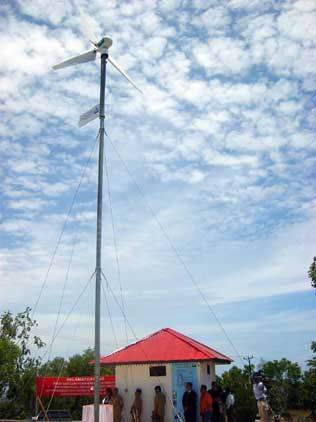Latulahat Windmill: Ambon, Maluku Islands
 Any use of alternative sources for fuel is far better than polluting the atmosphere and destroying the environment. The villagers in Latulahat have dwindling sources of fossil fuels and have turned to using windmill speed for power generation as an alternative source of power.
Any use of alternative sources for fuel is far better than polluting the atmosphere and destroying the environment. The villagers in Latulahat have dwindling sources of fossil fuels and have turned to using windmill speed for power generation as an alternative source of power.
Latulahat windmill a model for power self-reliance in rural areas
A 10-meter tower sits atop a hill on the west coast of Ambon Island, Maluku. On its peak, three propellers, measuring 4.5 meters in diameter each, rotate in the wind.
The windmill in Latulahat village isn’t just a power generating device; it’s a step toward energy independence and a cleaner environment.
Dwindling fossil fuel reserves, thus far the primary source of energy used to generate electricity in Indonesia, have driven some in the country to look for other sources of energy.
The pilot project is a joint venture between the Maluku provincial administration and Sciement Group from Russia.
The 5,000-watt windmill adjusts to handle wind speeds of between 3.5 meters and 25 meters per second and can supply three-phase electricity at between 220 to 380 volts. It should last up to 20 years and can power at least 40 households. The device not only produces electricity; it also pumps ground water.
Other rural areas could end up following Latulahat’s lead, said State Minister for the Development of Disadvantaged Regions Saifullah Yusuf when he launched the project recently. He credited the Maluku provincial administration with a significant breakthrough in the field of power generation.
“We should use the program being developed by the Maluku governor as an example,” he said.
Saifullah said rural areas were especially affected by the lack of alternative energy sources.
“Most villages have no access to electricity because they totally depend on the PLN state power company. Even if they are connected, they still can’t afford to use it.”
He said based on 2005 data, 30 percent of the 17,611 villages in Indonesia have never had access to electricity since the country gained its independence. Of the remaining villages, only half can afford to use electricity.
Of Maluku’s approximately 800 villages, 340 are not connected to the power network.
“The provincial administration’s effort to produce wind-generated electricity should be commended and jointly supported to promote power self-reliance in rural areas,” said Saifullah.
The types of energy appropriate for rural areas may vary. For example, an area which has less wind could develop a solar or hydropower system.
Maluku Governor Karel Albert Ralahalu said Maluku was uniquely positioned to take advantage of windmill technology.
“We should tap power from the wind because it would be very beneficial for Maluku, which consists of small islands situated in the center of the wind flow from Australia and the Pacific Ocean. The wind potential is enormous all year round,” said Karel.
He said people in rural areas could have access to electricity within 10 years by turning to local sources, especially renewable ones such as hydro, solar and wind.
Maluku Mining and Energy Office head Chris Hehanussa said the wind energy program was eco-friendly and inexpensive to operate because the windmill only needs lubricants to continue running.
M. Azis Tunny